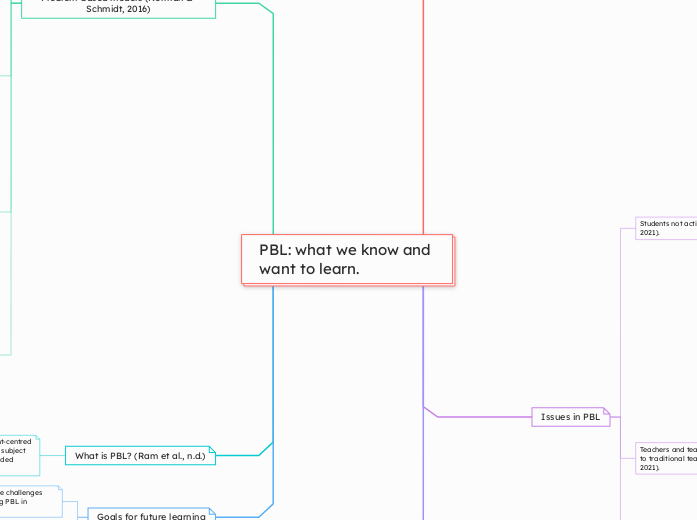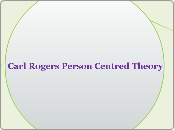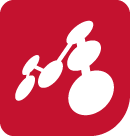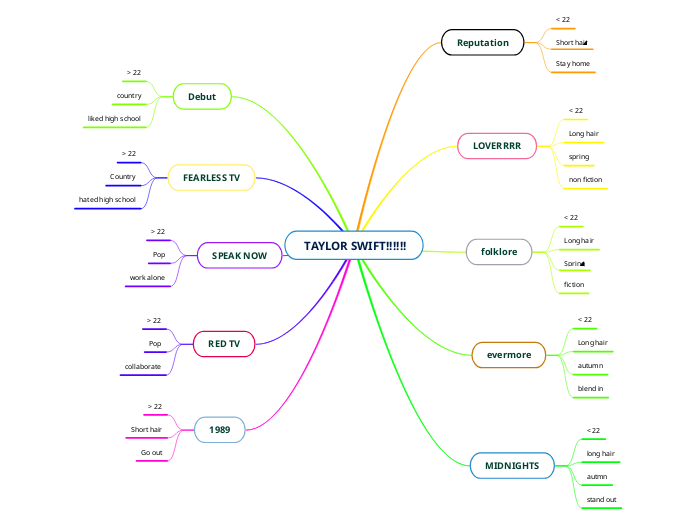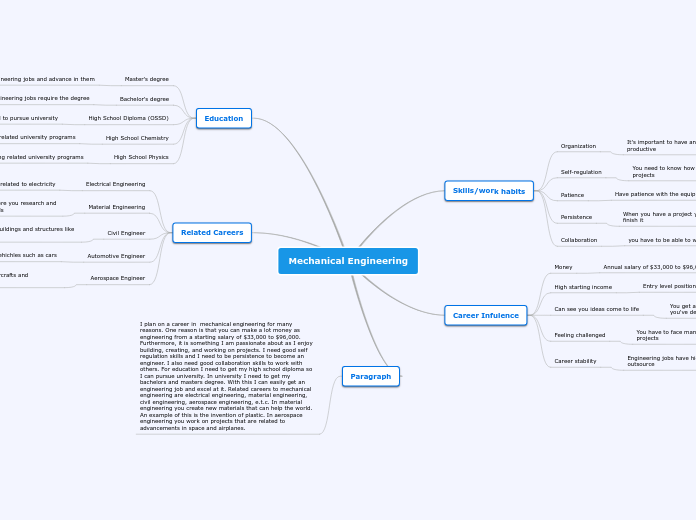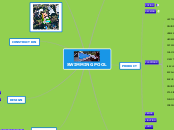PBL: what we know and want to learn.
Goals for future learning
I would like to learn about the long-term benefits of PBL for students.
I would like to learn more about the challenges teachers may face by implementing PBL in classrooms.
What is PBL? (Ram et al., n.d.)
Problem-based learning (PBL) is a student-centred approach in which students learn about a subject by working in groups to solve an open-ended problem.
Problem-based models (Norman & Schmidt, 2016)
Flipped Problem-Based Learning (FPBL) (Norman & Schmidt, 2016)
Steps to use in education for engineering and history classes
4. Final presentation
3. Reflection and Iteration
2. In-class problem solving
1. Pre-class preparation
Blends the principles of PBL with the flipped classroom approach, where students are introduced to content before class through videos or readings and engage in problem-solving activities during class.
Collaborative Problem Based Learning (Norman & Schmidt, 2016)
Steps to use in education for environmental science and literature
4. Presentation and peer review
3. Collaboration
2. Problem research
1. Group formation
Emphasizes working collaboratively to solve problems, combining elements of PBL with a focus on teamwork, communication, and collaboration.
Design Thinking Model (Norman & Schmidt, 2016)
Steps to use in education for engineering, art and design courses and business
5. Test
4. Prototype
3. Ideate
2. Design
1. Empathize
Creative problem-solving is particularly common in design, engineering, and business. It emphasizes empathy, ideation, and prototyping and testing solutions.
Inquiry-Based Learning (IBL) (Norman & Schmidt, 2016)
Steps to use in education for science, literature and math
5. Conclusion and reflection
4. Investigation
3. Hypothesis Formation
2. Exploration and research
1. Questioning
Student-driven inquiry and discovery. It is less about solving a specific problem and more about students exploring a topic or question in depth through investigation.
The Case-Based Learning (CBL) Model (Norman & Schmidt, 2016)
Steps to use in education in business, law education and social sciences
5. Feedback and reflection
4. Presentation of solutions
3. Research and solution development
2. Problem identification
1. Case introduction
Focuses more on analyzing specific case studies, often used in professional programs like law, business or healthcare.
Traditional Problem-Based Models (Norman & Schmidt, 2016)
Steps to use in education in medical education, history classes and STEM subjects
5. Reflection
4. Solution presentation
3. Hypothesis and solution development
2. Problem analysis and research
1. Introduction
Focuses on students working in small groups to solve an ill-structured problem. Students learn through the process of finding and analyzing information, developing solutions, and reflecting on the learning process.
How does PBL help students?
Teaches students communication skills
Making sure students are understanding the concepts.
Ensuring the classroom is a safe space that allows questions and to pause to go over something that needs to be clarified.
When educators ask if there are any questions before moving on, it allows students to voice if they need more clarification.
Group work
Allows students to practice their ability to communicate efficiently when they work collaboratively.
I realized the importance of good communication skills.
This skill prevents confusion and helps us stay focused.
Teaches students valuable research skills
Checking for key details.
Signs of authenticity
Reputable publisher
Author's authority
Source of information
Objectivity
Title
Publication date
Author's name
Comparing multiple websites for consistency in information.
How to verify sources for accurate information.
Solidifying that not all online information is trustworthy.
How to find accurate and reliable information.
Issues in PBL
Intense demands on faculty to implement PBL (Ram et al., n.d.)
Time is a huge factor in implementing PBL, time teachers do not usually have.
Teachers and teaching assistants are accustomed to traditional teaching methods (Liu & Yuan Liu, 2021).
Personal connection
I realized how easy it was to forget concepts without regular practice.
I helped him learn the topic by reteaching myself multiple methods to better his understanding.
My younger brother struggled in a u-prep calculus course because his teacher only taught one way to solve problems and lacked clear explanations.
Impact on teachers
Possible loss of patience and passion for teaching.
Frustration when required to implement PBL.
Challenges for new teachers
After leaving school, they may not continue learning about PBL unless tey seek it out independently.
Learn from experienced teachers who use traditional methods.
Focus of PBL
Primarily directed towards students, leaving teachers with less emphasis on learning PBL themselves (Liu & Yuan Liu, 2021).
Students not actively participating (Liu & Yuan Liu, 2021).
Change in perspective
Realized it improves both my learning and the teacher’s understanding.
Exposure to PBL taught me that questioning teachers is acceptable.
Personal experience
Believed teachers’ words were absolute.
Taught to respect certain adults (parents, elders, teachers) without questioning them.
Grew up shy and avoided speaking out or questioning teachers.
Cultural norms
Many people are accustomed to staying silent with contrasts with PBL’s interactive nature (Liu & Yuan Liu, 2021).
Example
Korean students often show blind respect for teachers, preferring to stay quiet rather than question or challenge them (Liu & Yuan Liu, 2021).
PBL theories of learning
Connectivism (Downes, 2010; Siemens, 2005)
Impact on PBL (Downes, 2010; Siemens, 2005)
Emphasizes the idea that knowledge is not fixed but constantly evolving as students interact with networks and information sources.
Encourages students to access and use various resources (online tools, experts, peers) to gather information and solve problems.
Key concepts (Downes, 2010; Siemens, 2005)
Learning happens through interaction with people, resources and technologies.
Learning is a process of connecting specialized information sources, knowledge is distributed across networks.
Self- Determination Theory (Ryan & Deci, 2017)
Impact on PBL (Ryan & Deci, 2017; Lopez-Garrido, 2023)
Collaboration also helps students.
Students make choices how to approach the project and are encouraged to set their own goals.
enhances intrinsic motivation by giving students a sense of ownership and autonomy over their learning.
Key concepts (Ryan & Deci, 2017; Lopez-Garrido, 2023)
learners are more motivated hen they feel competent and related to others.
Cognitive Load Theory created by Sweller (1988)
Impact on PBL (Lovell, 2020)
Manage complex information and tasks. By breaking projects into smaller, manageable tasks, scaffolding learning activities and providing resources and guidance.
Key concepts (Lovell, 2020)
Learning is most effective when the cognitive load is appropriately managed, avoiding overloading the working memory, and providing cognitive support when necessary.
Experimental Learning created by Kolb (1984)
Impact on PBL (EPM, 2020)
Places students in situations where they can engage in concrete experiences. (i.e. building a product or designing a plan) reflect on their process, develop new ideas and test their hypothesis).
Key concepts (EPM, 2020)
It involves a cyclical pattern of concrete experience, reflective observation, abstract conceptualization, and active experimentation.
Learning is a process whereby knowledge is created through the transformation of experience.
Situated Learning Theory created by Lave & Wenger (1991)
Impact on PBL (Smith, 2003, 2009)
Designed to reflect authentic, real-life scenarios, making the learning process relevant and meaningful.
Typically addresses real-world problems and challenges.
Key concepts (Smith, 2003, 2009)
This theory is most effective when it takes place in an authentic context where learners are actively engaged in real-life situations.
Social Learning Theory created by Bandura (1977)
Impact on PBL (Sprouts, 2022)
Students learn not only through their own actions but also by observing and discussing with their peers and mentors.
Fosters social learning by encouraging group work, peer feedback and interaction.
Key concepts (Sprouts, 2022)
Social context and interactions are essential for learning.
Learning occurs through observation, imitation, and modeling.
Constructivism created by Piaget (1968) & Vygotsky (1978)
Impact on PBL (Ozer, 2004)
Students are encouraged to discover, experiment, and problem-solve, which aligns with the idea that learners build upon their existing knowledge and understanding.
Students construct new knowledge through hands-on experiences, collaboration, and reflection.
Key concepts (Ozer, 2004)
Social interaction and cultural context are key elements.
Learning is an active process where learners build on their prior knowledge through experience.
